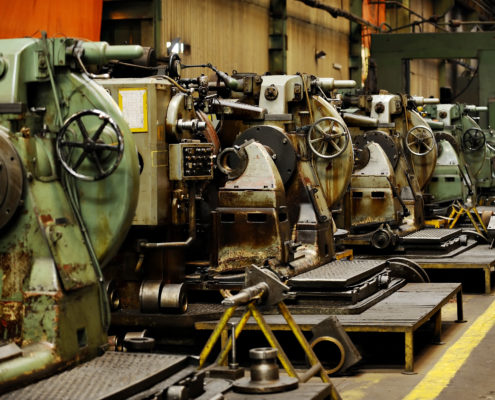endiio’s Retrofit Box equips old machines for the future
A revolutionary sensor retrofit system optimizes machine uptimes while reducing maintenance costs by 90%
Are all the machines in your company intelligent and interconnected? Not yet, probably. Right? According to an estimate from Bosch, in Germany alone there are still tens of millions of machines (!) in the manufacturing industry without a conditional monitoring technology. These machines don’t have sensors, software or connectivity to enterprise systems. And there is no automatic monitoring of machine uptimes. But that’s not all. These machines are also not equipped for predictive maintenance. In addition, these systems were also very expensive to buy. From the outset, their operating time was planned to amount to decades. Therefore, these machines can not simply be replaced with modern equipment. On the other hand, however, the economical use must be considered: Cost pressure and international competition force companies to improve their efficiency in production. But how do we achieve this improvement?
Limits of normal maintenance
So our goal is to improve efficiency and minimize the risk of failure of a machine. To achieve this we need more basic information about the current state of the machine. Today’s maintenance is often carried out preventively on suspicion. The downside of this approach: It is very time-consuming and sometimes, high costs arise due to the waste of the lifetime of a spare part. In addition, these maintenance cycles limit the availability of the machines. The alternative method is exclusively reactive maintenance. Here, too, the disadvantages are obvious: The machines that suddenly fail can stop the entire production process. The result is a costly shutdown.
Missing data exchange with the machine
Let’s look at a practical example — for example, at a company in the manufacturing industry (e.g. in mining). According to a “conventional” maintenance plan, regular inspections are planned for the DC motors, which are used as drives for conveyor belts. Thus, bearings are exchanged on the basis of a direct vibration analysis or on the basis of empirical data. A future “intelligent” automatic monitoring of the engines could reduce costly inspections. The maintenance cycles for components such as bearings are usually lengthened, as the occurrence of disturbances can be better predicted. Costly interruptions of the production process are thereby minimized, because not all faults can be eliminated through routine maintenance. The procedure: The data is documented by scheduled inspections and maintenance instructions by the specialist personnel. BUT: The personnel expenditure is high, because, unfortunately, these maintenances can not be automated for a whole plant location and be implemented at the touch of a button. If the machine has internal control data, it would be possible to analyze it. However, due to the high complexity, this often requires the involvement of the manufacturer of the machine or that of a dedicated service provider. The plant operator can rarely access this data himself. Therefore, he often lacks important information about the current state of the machines. The first important step to improve maintenance would be to know the exact machine operating times. But even this is a tricky thing with a non-networked machine because it requires networking of possible components, e.g. via an implementation of a signal line or a passive circuit on the machine.

Which solutions are already available on the market?
Of course, there is the possibility of retrofitting a machine to detect the current condition with the help of sensors and transmission technology. In doing so, safety and warranty issues must be considered. The implementation is then carried out by applying some modifications, e.g. the laying of cables for the power supply, the connection to a LAN or the construction of a wireless communication technology. After all, the data must be processed by intelligent software so that an actual state change can be detected. The one-off cost of retrofitting an “old” machine quickly adds up to a few thousand euros. In addition, the question arises as to how future extensions will be taken into account. What effort and follow-up costs must be expected if the process architecture around the single machine possibly changes over time? And what “new” maintenance costs for the transmission network will be added? When we look at this approach with our ROI glasses, we realize that we need a different solution.
The endiio Retrofit Box is a convincing solution
But what if there was an optimal retrofit solution after all? A solution that can be retrofitted to machines with minimal effort and can even be customized over time, if needed? A solution that has its own robust communication medium and an extremely economical and even self-sufficient data acquisition technology at the same time? Our endiio Retrofit Box solution allows the retrospective implementation of condition monitoring with an automatic machine hours counter without having to make any modifications to the machine. This solution, — we call it the “Retrofit Box” —, is based on an Internet of Things (IoT) sensor platform consisting of data acquisition, data transmission, data routing and data visualization and can be attached to the machine surface. Let me explain this in detail: The solution consists of the core product of the so-called Retrofit Box. There is more to the Retrofit Box than meets the eye — each Retrofit Box can be individually equipped with different sensors and can thus be used on many machines. In addition, the Retrofit Box includes a “mini power plant”, which can generate energy due to waste heat and light by means of a so-called “Thermoharvester” or a solar cell. The third component is a radio module. It uses an economical and specially developed radio technology to transfer the data to a gateway — even over a range of up to 100 meters. At the receiver surface, the data is displayed and evaluated by visualization software. The housing of the Retrofit Box can be individually adapted to the ambient conditions (heat development, materials, IP protection, etc.) and is thus separated from the inside at any time and also interchangeable.

So how does the Retrofit Box work in practice?
The acceleration sensors included in the Retrofit Box detect possible vibrations in a software controlled low power mode. The sensors then turn on and verify the vibration pattern. Exceeding / falling below a certain threshold (reference threshold) is recognized as an on or off operation of the machine. This is based on preset parameters (so-called reference values), which were determined by means of an initial reference measurement. Based on the transmitted status information (0 or 1) to the portal, the machine running time can be automatically calculated from this and visualized in the form of a “logbook”. Appropriate role management regulates access to this data. Alternatively, the data can also be further processed by means of so-called “edge computing” within a plant network. For this, there is no need to connect to a cloud portal via the Internet.
Possibilities of adaptation
With regard to future scenarios of process optimization, additional condition monitoring measures can be implemented in the Retrofit Box system based on the existing platform without having to make any changes. With the existing sensors (temperature, acceleration and magnetic field sensors) additional information of the machine can be recorded and processed. This is advantageous, because with these data, irregularities during operation can be detected automatically in addition to the machine operating times. In addition, the platform concept itself allows the implementation of new sensors in the existing Retrofit Box housing — both software and hardware wise. The retrofit platform provides vital information for inspection, proactive maintenance and machine utilization rate, but requires little design complexity and minimal maintenance effort, and can be easily customized to extend use cases.
Challenge us
We believe that there are virtually unlimited applications for the use of the Retrofit Box. We would very much like to talk to you about this. Please contact us and challenge us with your current solution requests.
Markus Dorn
Vice President Product Management & Sales
endiio GmbH
Seestadtstraße 27
1220 Vienna
dorn@endiio.com
+43 664 916 5695


